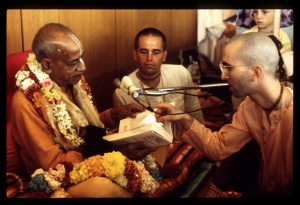CC Madhya 21.144 (1975)

A.C. Bhaktivedanta Swami Prabhupada
TEXT 144
- kāṇera bhitara vāsā kare, āpane tāṅhā sadā sphure,
- anya śabda nā deya praveśite
- āna kathā nā śune kāṇa, āna balite bolaya āna,
- ei kṛṣṇera vaṁśīra carite
SYNONYMS
kāṇera—the hole of the ear; bhitara—within; vāsā kare—makes a residence; āpane—personally; tāṅhā—there; sadā—always; sphure—is prominent; anya—other; śabda—sounds; nā—not; deya—allows; praveśite—to enter; āna kathā—other talks; nā—not; śune—hears; kāṇa—the ear; āna—something else; balite—to speak; bolaya—speaks; āna—another thing; ei kṛṣṇera—of Lord Kṛṣṇa; vaṁśīra—of the flute; carite—characteristics.
TRANSLATION
"The vibration of His flute is just like a bird that creates a nest within the ears of the gopīs and always remains prominent there, not allowing any other sound to enter their ears. Indeed, the gopīs cannot hear anything else, nor are they able to concentrate on anything else, not even to give a suitable reply. Such are the effects of the vibration of Lord Kṛṣṇa's flute."
PURPORT
The vibration of Kṛṣṇa's flute is always prominent in the ears of the gopīs. Naturally they cannot hear anything else. Constant remembrance of the holy sound of Kṛṣṇa's flute keeps them enlightened and enlivened, and they do not allow any other sound to enter their ears. Since their attention is fixed on Kṛṣṇa's flute, they cannot divert their minds to any other subject. In other words, a devotee who has heard the sound of Kṛṣṇa's flute forgets to talk or hear of any other subject. This vibration of Kṛṣṇa's flute is represented by the Hare Kṛṣṇa mahā-mantra. A serious devotee of the Lord who chants and hears this transcendental vibration becomes so accustomed to it that he cannot divert his attention to any subject matter not related to Kṛṣṇa's blissful characteristics and paraphernalia.